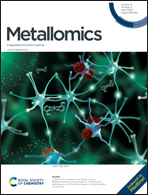Gene expression in mouse muscle over time after nickel pellet implantation†
Abstract
The transition metal nickel is used in a wide variety of alloys and medical devices. Nickel can cause a range of toxicities from allergy in humans to tumors when implanted in animals. Several microarray studies have examined nickel toxicity, but so far none have comprehensively profiled expression over an extended period. In this work, male mice were implanted with a single nickel pellet in the muscle of the right leg with the left leg used as a control. At 3 week intervals up to 12 months, nickel concentrations in bioflulids and microarrays of surrounding tissue were used to track gene expression patterns. Pellet biocorrosion resulted in varying levels of systemic nickel over time, with peaks of 600 μg L−1 in serum, while global gene expression was cyclical in nature with immune related genes topping the list of overexpressed genes. IPA and KEGG pathway analyses was used to attribute overall biological function to changes in gene expression levels, supported by GO enrichment analysis. IPA pathways identified sirtuin, mitochondria, and oxidative phosphorylation as top pathways, based predominantly on downregulated genes, whereas immune processes were associated with upregulated genes. Top KEGG pathways identified were lysosome, osteoclast differentiation, and phasgosome. Both pathway approaches identified common immune responses, as well as hypoxia, toll like receptor, and matrix metalloproteinases. Overall, pathway analysis identified a negative impact on energy metabolism, and a positive impact on immune function, in particular the acute phase response. Inside the cell the impacts were on mitochondria and lysosome. New pathways and genes responsive to nickel were identified from the large dataset in this study which represents the first long-term analysis of the effects of chronic nickel exposure on global gene expression.



 Please wait while we load your content...
Please wait while we load your content...